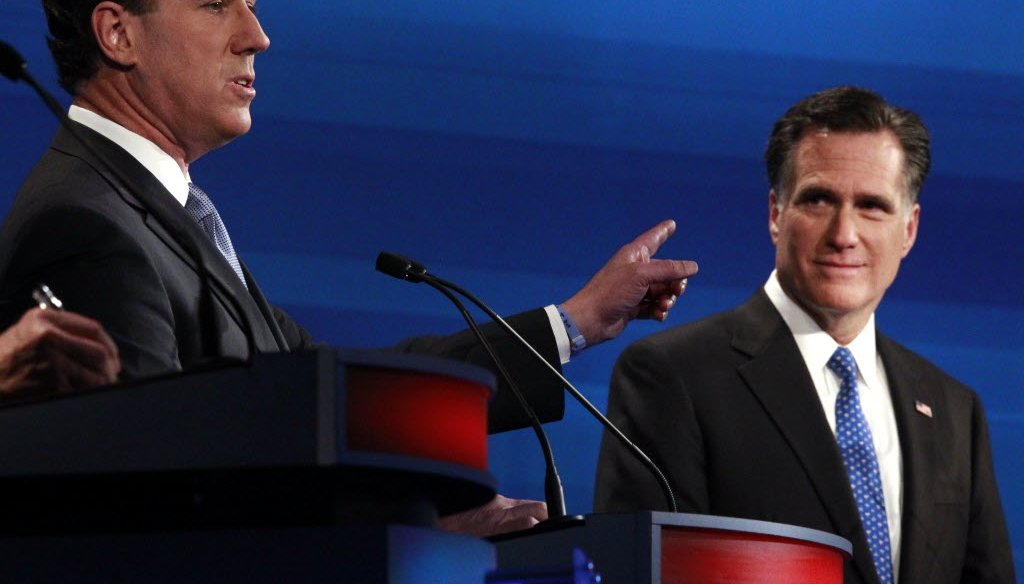Get PolitiFact in your inbox.

In this Associated Press photo, GOP presidential candidates Rick Santorum and Mitt Romney participate in a debate in South Carolina. They face off again April 3, 2012 in primaries in Wisconsin, Maryland and D.C.
As the Republican presidential campaign moved to Wisconsin, the attack ads followed.
Two national political action committees have been airing a pair of television ads -- one from the Red, White and Blue Fund attacks front-runner Mitt Romney, and a second, from Restore Our Future, goes after Rick Santorum.
The ads contain a variety of claims that PolitiFact National or other state sites have reviewed during the course of earlier primaries. Here’s a summary of each ad and the claims. Full items can be found at politifact.com.
Restore our Future ad, "Rick Santorum on the Economy."
Claim: While in the U.S. Senate, Santorum "voted for billions in wasteful spending, including the ‘Bridge to Nowhere.’"
PolitiFact Texas weighed a similar claim against Santorum raised by then-candidate Texas Gov. Rick Perry. The bridge in question was a $400 million plan to connect two small towns in Alaska. The issue played a prominent role in the the 2008 campaign when GOP Vice Presidential nominee Sarah Palin said that, as governor, she told Congress no thanks to the bridge.
So did Santorum support the bridge?
In 2005, a $286.5 billion federal highway and transportation bill included about $225 million for the Gravina Island bridge project in Alaska. On July 29, 2005, the U.S. Senate passed the legislation with a vote of 91-4. Santorum was among the backers of the bill.
There was another vote on an amendment that would have moved funding from the bridge to fix a bridge in Louisiana damaged by Hurricane Katrina. The amendment failed 82-15. Santorum was in the majority, voting against killing the funding for the so-called Bridge to Nowhere.
That claim was rated Mostly True because Santorum voted for the massive highway bill that included the bridge and then voted down an amendment that would have ended funding for the bridge.
Claim: Santorum "voted against national right to work legislation."
That claim stems from a procedural vote taken July 10, 1996 that would have allowed consideration of the National Right to Work Act of 1995. The measure, among other things, would have amended the National Labor Relations Act and the Railway Labor Act to repeal federal provisions that require employees to pay union dues or fees as a condition of employment. Santorum voted against allowing the bill to be debated, and it remained blocked. Santorum says today that he supports national right to work legislation. The claim based on the past vote was rated Half True.
Red, White and Blue Fund ad, "Mitt Romney: What Kind of President?"
Claim: Romney raised taxes and fees by over 700 million dollars.
Sen. John McCain (R-Ariz.) raised this in the 2008 campaign. Romney said he didn’t raise taxes, but did raise fees ($260 million), and closed loopholes that resulted in some businesses having to pay more taxes (estimates ranged from $377 million to $500 million). The claim was rated Half True.
Claim: Under Romney, Massachusett's job growth was nearly five times slower than other states.
A version of this claim was made by Democrats, including President Obama’s re-election strategist David Axelrod in June 2011. They said that, under Romney, Massachusetts ranked 47 out of 50 in terms of state job growth. The claim was rated Half True because experts say it’s impossible to say that the governor is responsible for the job numbers.
Claim: Romney left Massachussets "a projected debt of over $1 billion."
PolitiFact evaulated a similar claim by the same group in Feb. 2012 -- with one important difference. The ad evaluated said Romney left the state "$1 billion in debt." The ad aired in Wisconsin includes the word "projected."
The evaluated claims stems from three newspaper articles gathered as part of opposition research done in 2008 by the McCain campaign. The deficit was estimated to range from $400 million to $1 billion.
The claim was rated False because the articles referred to projected shortfalls that ultimately did not materialize. And the number in question was a projected shortfall, or deficit, rather than a debt.
Our Sources
Restore our Future ad, "Rick Santorum on the Economy."
Red, White and Blue Fund ad, "Mitt Romney: What Kind of President?"
PolitiFact items as noted



















































